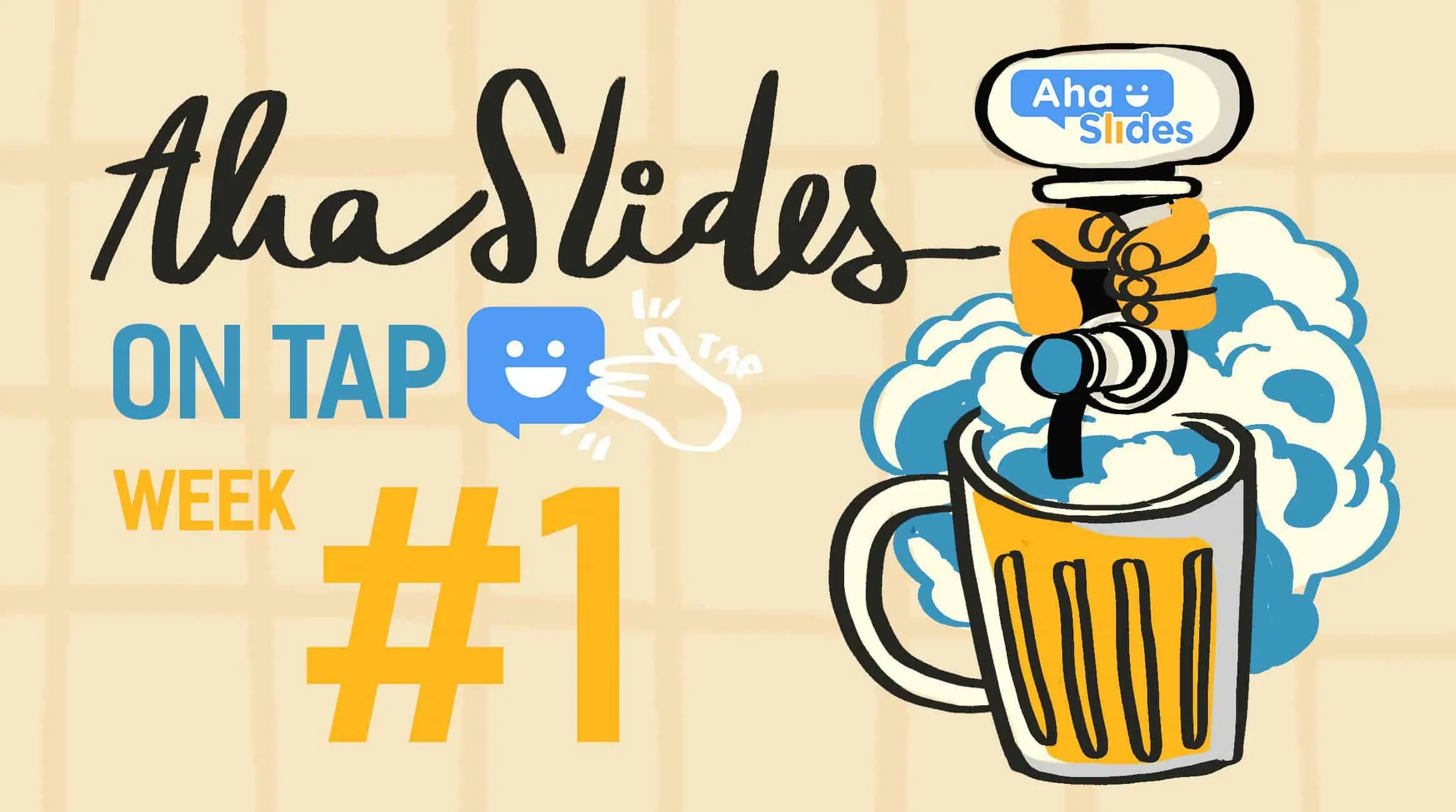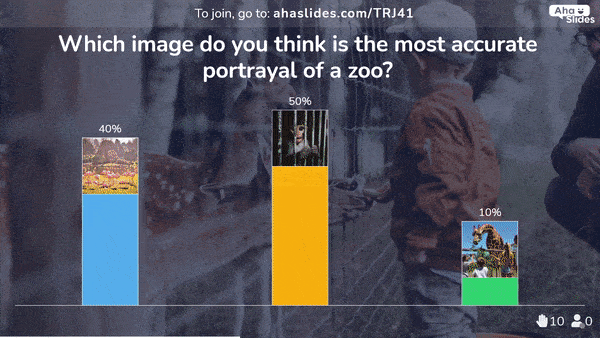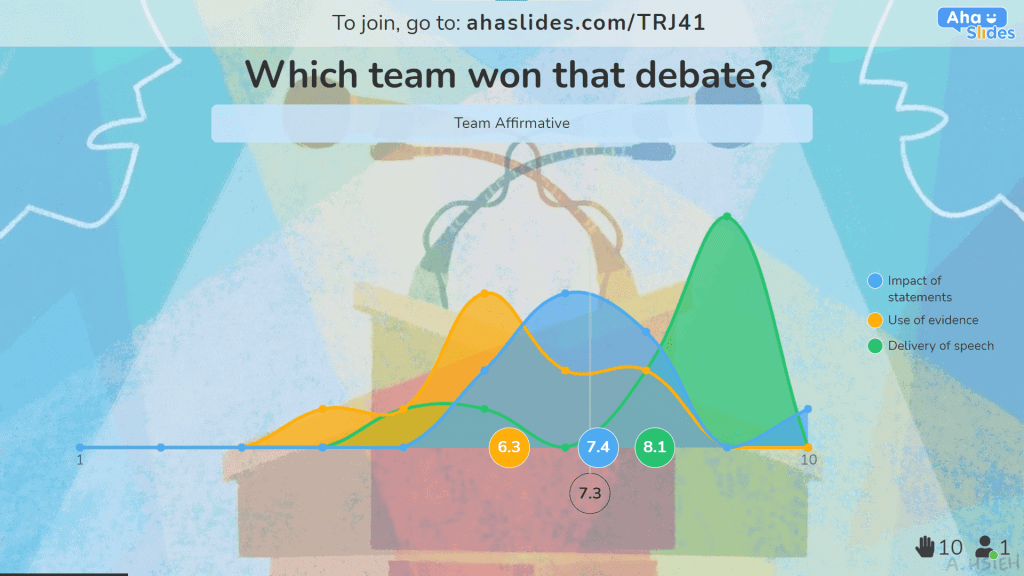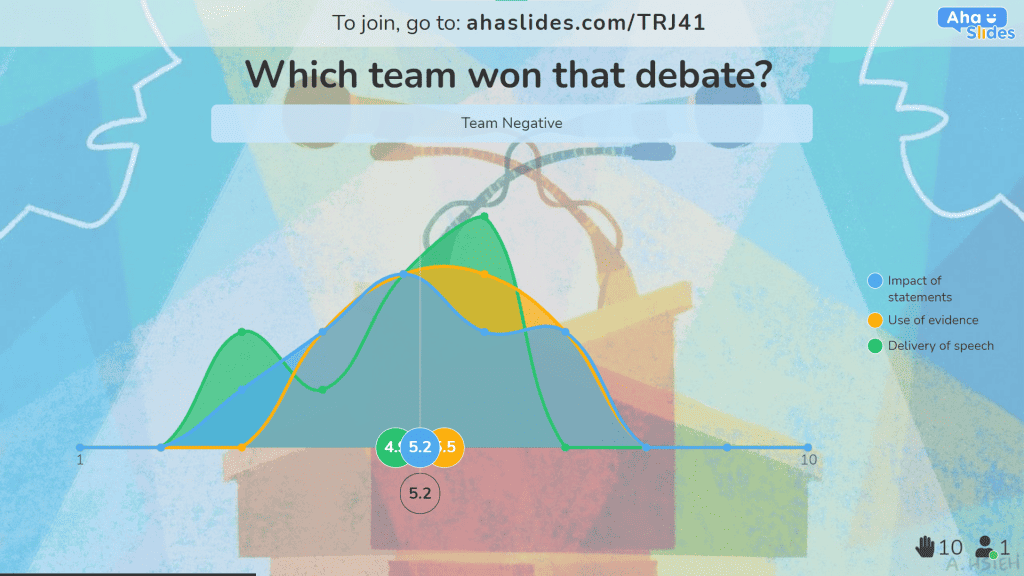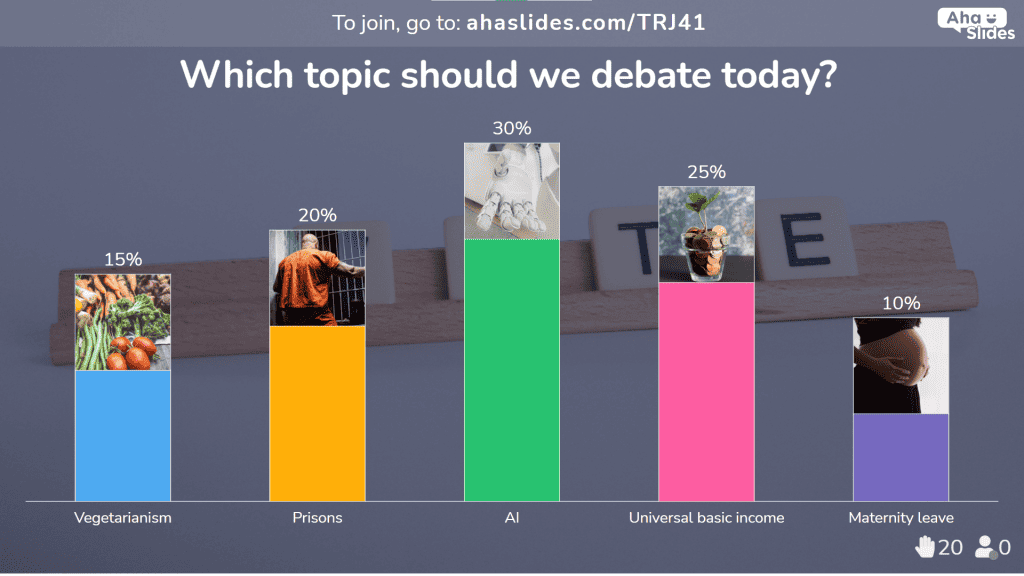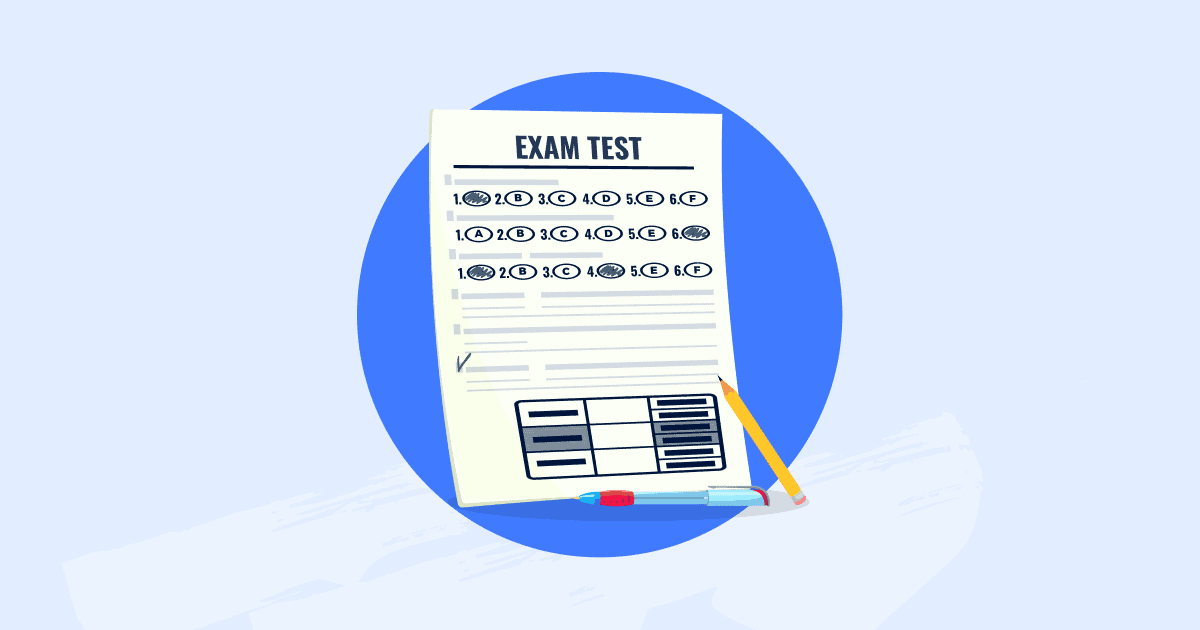這裡沒有爭論; 學生辯論 是鼓勵批判性思維的最佳方式之一, 吸引學生 並將學習交到學習者的手中。
那麼,如何開展學生辯論呢?辯論課並非只適合辯論型課堂或初露頭角的政治家,也並非只適合規模較小或較成熟的課程。學生辯論面向所有人,它理所當然地成為了學校課程的支柱。
在這裡,我們深入 課堂辯論的世界. 我們著眼於好處和各種類型的學生辯論,以及主題、一個很好的例子,以及至關重要的是,如何通過 6 個簡單的步驟建立自己富有成效、有意義的課堂辯論。
了解我們的更多信息 互動課堂活動!
Overview
| 辯論應該持續多少分鐘? | 5分鐘/節 |
| 誰是辯論之父? | 阿布德拉的普羅泰戈拉 |
| 第一次辯論是什麼時候? | 公元前 485-415 年 |
AhaSlides 的更多提示
如何舉辦學生辯論?目錄
為什麼學生辯論需要更多的愛

定期進行課堂辯論可以深刻地影響學生的個人生活和職業發展。以下列舉了一些例子,說明進行有意義的課堂討論對學生的現在和未來都是一項非常有價值的投資:
- 說服的力量 – 學生辯論教會學習者,任何僵局總能找到深思熟慮、以數據為基礎的方法來解決。學生學習如何建構令人信服、經過深思熟慮的論點,對某些人來說,這些論點可能對未來的日常事務有所幫助。
- 寬容的美德 另一方面,在課堂上進行學生辯論也能培養傾聽技巧。它教導學生真正傾聽與自己不同的觀點,並理解這些差異的根源。即使在辯論中失敗,也能讓學生明白,改變對某件事的看法是可以的。
- 100% 線上可能 – 在教師們仍在努力將課堂體驗轉移到線上的當下,學生辯論提供了一種無需實體空間、輕鬆便捷的活動。當然,有些環節需要調整,但學生辯論完全可以成為你線上教學方法的一部分。
- 以學生為中心 – 以學生而非學科為學習中心的好處 已經充分探索. 學生辯論讓學習者或多或少可以自由支配他們所說的話、他們所做的事情以及他們如何回應。
舉行學生辯論的 6 個步驟
步驟#1 - 介紹主題
對於辯論的結構,首先,自然地,舉辦學校辯論的第一步就是給他們一些可說的話。 課堂辯論的話題範圍幾乎是無限的,甚至是即興辯論主題。 你可以提供任何陳述,或提出任何是/否問題,只要保證辯論規則,就讓雙方進行討論。
儘管如此,最好的話題是讓全班的意見盡可能接近中立的話題。如果你需要一些靈感,我們準備了40個學生辯論主題 在這裡.
選擇完美主題的一個好方法是通過 在你的課堂上收集關於它的初步意見,並查看哪一方的學生人數或多或少是偶數:

儘管像上面這樣的簡單是/否民意調查可能會做,但還有許多其他創造性的方法來確定和設置主題供您的學生討論:
- 圖片投票 – 展示一些圖像,看看每個學生最認同哪一張。
- 詞云 – 觀察班級在表達意見時使用同一個字的頻率。
- 評定量表 – 以滑動比例呈現陳述並讓學生對一致性進行 1 到 5 的評分。
- 開放式問題 – 讓學生自由表達對某個主題的看法。
免費下載! ⭐ 您可以在下方的免費 AhaSlides 範本中找到所有這些問題。您的學生可以透過手機即時回答這些問題,然後查看全班同學意見的視覺化數據。
步驟2-創建團隊並確定角色
有了這個話題,下一步就是形成 2 方討論它。 在辯論中,這些方面被稱為 肯定 和 負。
- 團隊肯定 – 同意所提議的聲明(或對所提出的問題投「贊成」票)的一方,這通常是對現狀的改變。
- 團隊負面 – 該方不同意所提出的聲明(或對所提出的問題投反對票),並希望維持現狀。
實際上,至少需要兩組人。如果你的班級規模很大,或者有相當多的學生對正方或反方意見不完全贊同,你可以透過增加團隊數量來拓展學習潛力。
- 團隊中間地帶 – 一方希望改變現狀,但仍保留一些不變的內容。他們可以反駁任何一方的觀點,並嘗試在兩者之間找到妥協。
尖端 #1 💡 不要懲罰騎牆派。雖然進行學生辯論的原因之一是為了讓學習者更自信地表達自己的觀點,但有時他們 真正處於中間立場讓他們採取這種立場,但他們應該知道,這並不是逃避辯論的門票。
你的課程的其餘部分將包括 裁判他們將聽取辯論中的每個要點,並根據每個團隊的表現對整體表現進行評分。 計分系統 你晚點出發。
至於每位發言者的團隊角色,你可以隨意設定。在課堂上學生辯論中,英國議會辯論的形式很受歡迎:
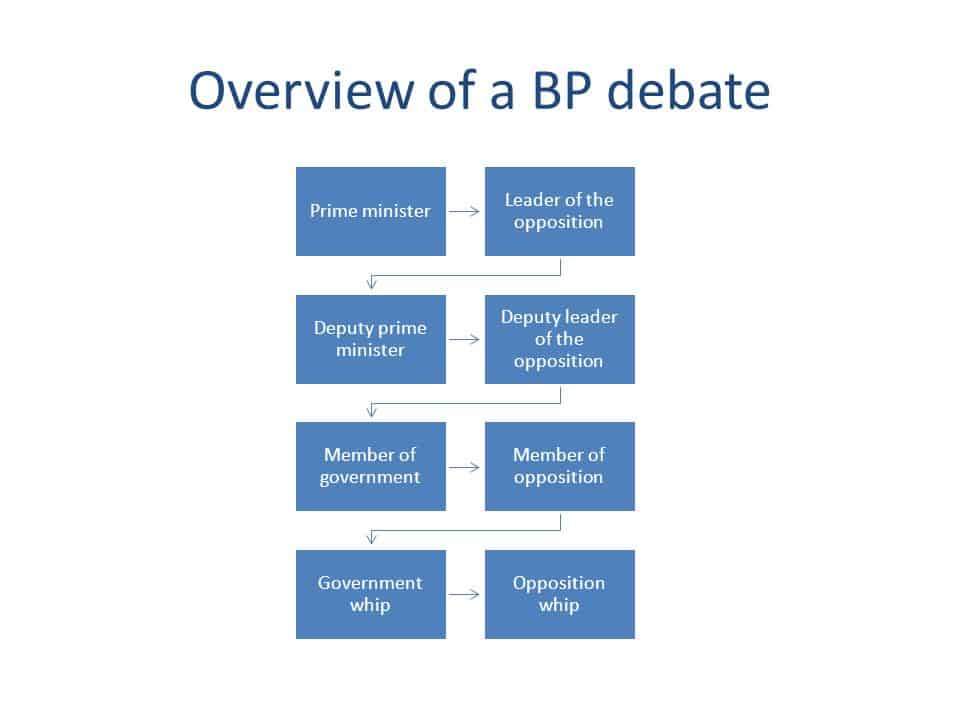
這涉及每個團隊有 4 名發言人,但您可以通過為每個角色分配兩名學生並在分配的時間內給他們每人一分來將其擴展到更大的班級。
步驟#3——解釋其工作原理
在開始之前,您必須明確學生辯論的 3 個關鍵部分。 這些是你對可能在社會中經歷的那種無政府主義辯論的障礙 實際 英國議會。 辯論的重要部分是 結構是, 規則 和 計分系統.
— 結構 —
學生辯論首先需要有堅實的結構並遵守辯論準則。 它需要是 側 這樣沒有人可以互相交談,並且需要允許足夠的 時間 供學習者提出自己的觀點。
查看此示例學生辯論的結構。 辯論總是從團隊肯定開始,然後是團隊否定
| 團隊肯定 | 團隊負面 | 每個團隊的時間津貼 |
| 開幕詞 由第一個發言者。 他們將陳述他們對擬議變更的主要支持點 | 開幕詞 由第一個發言者。 他們將陳述他們對擬議變更的主要支持點 | 5分鐘 |
| 準備反駁. | 準備反駁. | 3分鐘 |
| 反駁 由第二位發言者發言。他們將反駁負面隊在開場陳述中提出的觀點。 | 反駁 由第二位發言者發言。他們將反駁正方隊在開場陳述中提出的觀點。 | 3分鐘 |
| 第二次反駁 由第三位發言者發言。他們將反駁負面團隊的反駁。 | 第二次反駁 由第三位發言者發言。他們將反駁正方團隊的反駁。 | 3分鐘 |
| 準備反駁和結案陳詞。 | 準備反駁和結案陳詞。 | 5分鐘 |
| 最後的反駁和結案陳詞 由第四位發言者。 | 最後的反駁和結案陳詞 由第四位發言者。 | 5分鐘 |
提示#2 💡 學生辯論的結構可以靈活,同時嘗試哪些有效但 應該一成不變 最終結構確定後,請注意時間,不要讓發言者超出他們的發言時間。
— 規則 —
規則的嚴格程度取決於你的班級在聽到開場白後會不會變成政客。然而,無論你教誰,總會有過於活躍的學生和不願意發言的學生。明確的規則有助於你創造公平的競爭環境,並鼓勵每個人參與。
以下是您可能希望在課堂討論中使用的一些內容:
- 遵守規則!還沒到你說話的時候就別說話。
- 保持主題。
- 不發誓。
- 不訴諸人身攻擊。
— 評分系統 —
儘管課堂辯論的目的實際上並不是“贏”,但你可能會發現,學生天生的競爭意識要求進行一些基於觀點的安撫。
您可以為以下對象獎勵積分…
- 有影響力的陳述
- 有數據支持的證據
- 雄辯的交付
- 強大的肢體語言
- 相關視覺效果的使用
- 對題目的真實理解
當然,判斷一場辯論從來都不是純粹的數字遊戲。 您或您的評委團隊必鬚髮揮您最好的分析技能來為辯論的每一方打分。
提示#3 💡 用於辯論 ESL課堂, 在使用的語言比得分重要得多的地方,您應該獎勵標準,例如不同的語法結構和高級詞彙。 同時,使用母語也可以扣分。
步驟#4 –研究和寫作的時間

大家都清楚主題和課堂討論規則了嗎?太好了!現在該準備論點了。
就你而言,你在這裡要做的是 設定時間限制 為了研究,列出一些 預定來源 信息,然後監控你的學生,確保他們 保持主題.
他們應該研究他們的觀點和 頭腦風暴 預測對手可能提出的反駁,並決定如何回應。同樣,他們也應該預測對手的觀點,並考慮如何反駁。
步驟#5 - 準備房間(或Zoom)
當您的團隊正在確定積分時,就該為表演做準備了。
盡量營造專業辯論的氛圍,將桌椅放在房間的對面。通常,演講者會站在自己桌子前的講台上,講完後再回到自己的桌子。
當然,如果你在網路上主持學生辯論,事情會稍微困難一些。不過,還是有一些有趣的方法可以 在 Zoom 上區分團隊:
- 讓每個團隊拿出來 球隊顏色 並用它們來裝飾他們的 Zoom 背景或將它們作為制服穿著。
- 鼓勵每個團隊發明一個 團隊吉祥物 並讓每個成員在辯論時在屏幕上展示它。
步驟#6——辯論!
讓戰鬥開始!
記住,這是你學生展現才華的時刻;盡量少插嘴。如果你必須發言,請確保只是為了維持課堂秩序,或傳達課堂結構或評分制度。此外,以下是一些 介紹實例 讓您在辯論中大放異彩!
根據您在評分系統中列出的標準,為每個團隊進行評分,以此結束辯論。評審可以在整個辯論過程中填寫每個標準的分數,然後統計分數,每個長條圖的平均分數將作為該團隊的最終得分。
提示#4 💡 直接進入深度辯論分析可能很誘人,但這是 最好保存到下一課. 讓學生放鬆,思考要點,下次再來分析。
嘗試不同類型的學生辯論
上面的結構有時被稱為 林肯-道格拉斯格式因亞伯拉罕·林肯和史蒂芬·道格拉斯之間一系列激烈的辯論而聞名。然而,課堂辯論的技巧不只一種:
- 角色扮演辯論 - 讓學生根據虛構或非虛構人物的觀點進行辯論。這是一個很好的方法,可以讓他們敞開心扉,嘗試提出一個令人信服的論點,並提出與自己不同的觀點。
- 即興辯論 – 就像突擊測驗一樣,但用於辯論!即興的學生辯論讓發言者沒有時間準備,這對即興發揮和批判性思考能力的鍛鍊非常有益。
- 市政廳辯論 – 兩名或兩名以上學生面向觀眾,回答他們的問題。雙方都有機會回答每個問題,並且可以互相反駁,但必須保持禮貌!
查看最佳 13 個驚人的 在線辯論遊戲 適合所有年齡層的學生(+30 個主題)!

需要更多方法來吸引學生嗎? 💡看看這些 12個學生參與的想法 或者 翻轉教室 技術,適用於現場和線上課堂!
40個學生辯論主題
您是否正在尋找一些靈感來將辯論帶到課堂上? 瀏覽下面這 40 個學生辯論主題,並與您的學生投票決定選擇哪個。
學生辯論的學校主題
- 我們是否應該創建一個混合教室並同時進行遠程和課堂學習?
- 我們應該禁止在學校穿制服嗎?
- 我們應該禁止家庭作業嗎?
- 我們應該嘗試翻轉課堂學習模式嗎?
- 我們應該在外面多學習嗎?
- 我們是否應該廢除考試,並透過課程作業來測驗?
- 每個人都應該上大學嗎?
- 大學學費應該低一些嗎?
- 我們應該上投資課嗎?
- 電子競技應該成為體育課的一部分嗎?
學生辯論的環境話題
- 我們應該禁止動物園嗎?
- 是否應該允許將異國情調的貓作為寵物飼養?
- 我們應該建造更多的核電站嗎?
- 我們是否應該嘗試在全球範圍內降低出生率?
- 我們是否應該禁止 全部 一次性塑料?
- 我們應該把私人草坪變成分配地和野生動物棲息地嗎?
- 我們是否應該成立一個『國際環境政府』?
- 我們是否應該強迫人們改變應對氣候變化的方式?
- 我們是否應該阻止「快時尚」?
- 我們是否應該禁止在擁有良好火車和巴士系統的小國的國內航班?
學生辯論的社會話題
- 我們應該嗎 全部 是素食主義者還是素食主義者?
- 我們應該限制玩電子遊戲的時間嗎?
- 我們應該限制花在社交媒體上的時間嗎?
- 我們應該讓所有浴室都性別中立嗎?
- 是否應該延長標準產假?
- 我們應該繼續發明可以做的人工智能嗎? 全部 工作?
- 我們應該有普遍的基本收入嗎?
- 監獄應該用來懲罰還是改造?
- 我們應該採用社會信用體係嗎?
- 我們應該禁止使用我們數據的廣告嗎?
學生辯論的假設主題
- 如果永生是一種選擇,你會接受嗎?
- 如果偷竊合法,你會這樣做嗎?
- 如果我們可以輕鬆且廉價地克隆動物,我們應該這樣做嗎?
- 如果一種疫苗可以預防 全部 傳染性疾病,我們應該強迫人們服用嗎?
- 如果我們可以輕鬆地搬到另一個像地球這樣的星球,我們應該嗎?
- If 沒有 動物有滅絕的危險,所有動物的養殖都應該合法嗎?
- 如果你可以選擇從不工作,仍然過著舒適的生活,你會嗎?
- 如果你可以選擇在世界任何地方舒適地生活,你明天會搬家嗎?
- 如果你可以選擇買一隻小狗或領養一隻老狗,你會選擇哪個?
- 如果外出就餐和自己做飯是一樣的價格,你會每天都在外面吃飯嗎?
您可能希望將這些辯論主題的一部分提供給您的學生,他們將擁有最終發言權。 為此,您可以使用簡單的民意調查,或者就每個主題的特徵提出更細微的問題,看看學生最喜歡討論哪個主題。
免費為您的學生投票! ⭐ AhaSlides 幫助您將學生置於課堂的中心,並透過即時投票、問答和想法交流等方式讓學生表達自己的意見。在提高學生參與度方面,AhaSlides 的角色毋庸置疑。
完美的學生辯論範例
我們將為您呈現韓國廣播電視網《阿里郎》節目中學生辯論的絕妙範例之一。該節目 智力——高中辯論, 幾乎涵蓋了教師應該渴望將其帶到課堂上的精彩學生辯論的方方面面。
一探究竟:
提示#5 💡 控制你的期望。這個計畫裡的孩子絕對是高手,很多孩子即使英語是第二語言,也能在辯論中表現出色。不要指望你的學生也能達到同樣的水平—— 必要的參與是一個好的開始!
常見問題(FAQ)
有問題嗎?我們有答案。
